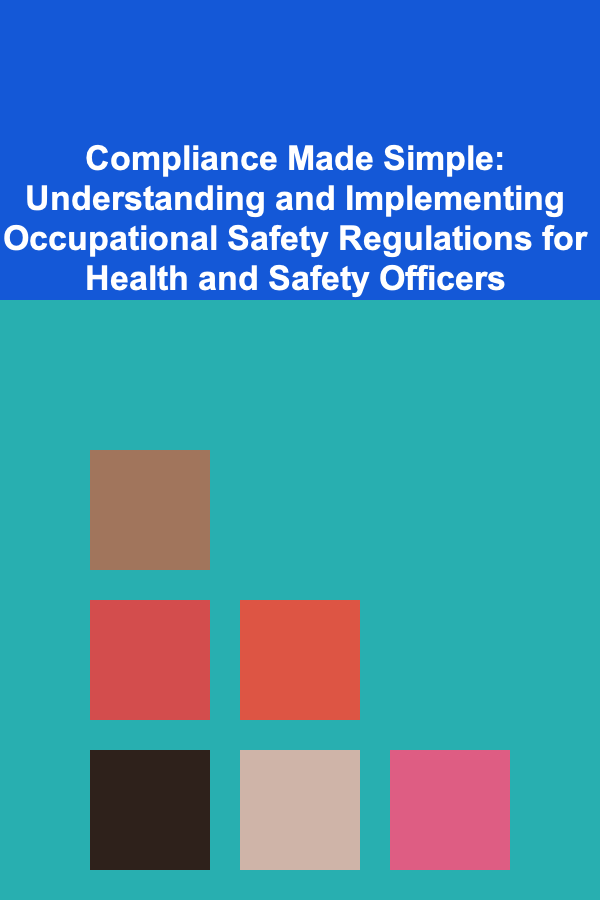
Compliance Made Simple: Understanding and Implementing Occupational Safety Regulations for Health and Safety Officers
ebook include PDF & Audio bundle (Micro Guide)
$12.99$6.99
Limited Time Offer! Order within the next:

Occupational health and safety (OHS) regulations are essential to ensuring the well-being of employees and minimizing workplace hazards. For Health and Safety Officers (HSOs), understanding these regulations and effectively implementing them is crucial for maintaining a safe work environment. Navigating the complex world of compliance can seem daunting, but with the right approach, it becomes manageable. This guide explores the fundamental principles of OHS regulations, key strategies for implementation, and practical steps HSOs can take to foster a culture of compliance in their organizations.
What Are Occupational Safety Regulations?
Occupational safety regulations are laws, rules, and guidelines established by governmental bodies or regulatory authorities aimed at protecting the health and safety of workers. These regulations are designed to reduce workplace injuries, illnesses, and fatalities by setting standards for working conditions, equipment, processes, and employee behavior. Compliance with these regulations is not just a legal obligation; it is a critical part of promoting a safe and healthy work environment.
Some of the most widely recognized regulatory bodies include:
- Occupational Safety and Health Administration (OSHA) in the U.S.
- Health and Safety Executive (HSE) in the UK
- National Institute for Occupational Safety and Health (NIOSH) in the U.S.
- European Agency for Safety and Health at Work (EU-OSHA) for EU member states
These agencies outline specific requirements for various industries, from construction to healthcare, and cover everything from personal protective equipment (PPE) to emergency preparedness.
Why Compliance is Crucial for Health and Safety Officers
As a Health and Safety Officer, the primary responsibility is to ensure that the workplace adheres to OHS regulations. Compliance is critical for several reasons:
1. Preventing Workplace Injuries and Illnesses
OHS regulations are designed to mitigate risks and reduce the likelihood of accidents. Non-compliance could result in workplace injuries, diseases, or even fatalities, directly impacting employee well-being and the company's reputation.
2. Legal and Financial Repercussions
Failure to comply with occupational safety regulations can result in significant penalties, including fines and sanctions. In more severe cases, an organization might face lawsuits or closures. Additionally, workers' compensation claims can escalate costs, both financially and in terms of public relations.
3. Enhancing Employee Morale and Productivity
A workplace that is compliant with safety regulations fosters a sense of security and trust. Employees are more likely to be engaged and productive when they feel that their health and safety are prioritized. Furthermore, demonstrating a commitment to safety can increase employee retention and reduce absenteeism.
4. Maintaining Reputation and Business Continuity
Compliance ensures that an organization operates within the legal frameworks set by relevant authorities. This not only helps the company avoid penalties but also contributes to a positive reputation within the industry, which is essential for maintaining long-term business continuity.
Key Regulations Every Health and Safety Officer Should Know
While specific regulations may vary depending on the industry and region, there are some core regulations that every HSO should be familiar with. These include:
1. Hazard Communication Standards (HCS)
The Hazard Communication Standard (HCS) requires employers to provide information about hazardous chemicals that employees may be exposed to. This includes labeling chemicals, maintaining safety data sheets (SDS), and training employees on how to safely handle hazardous substances. HSOs must ensure that all chemicals in the workplace are properly labeled and that employees have access to SDS for reference.
2. Personal Protective Equipment (PPE) Regulations
Personal protective equipment is essential in many workplaces to prevent exposure to physical, chemical, or biological hazards. OSHA mandates that employers provide appropriate PPE and training on its proper use, care, and maintenance. As an HSO, you must ensure that the right PPE is available to employees and that they are trained to use it correctly.
3. Workplace Safety Inspections
Regular safety inspections are a cornerstone of OHS compliance. Regulations require routine audits to identify hazards, assess risks, and implement corrective actions. HSOs must establish a system for conducting these inspections and ensure that they are thorough, objective, and documented. Inspections should cover everything from machinery to workplace ergonomics.
4. Emergency Action Plans
In many industries, emergency action plans (EAP) are required by law. These plans outline procedures for evacuations, medical emergencies, fires, and other crises. The HSO's role in this regard is to develop, implement, and regularly update these plans to ensure they are effective. Emergency drills should be conducted frequently to ensure that employees know how to react in the event of an emergency.
5. Employee Training and Education
Ongoing training is not only required but also vital to keeping employees informed of potential risks and safe practices. Regulatory standards often specify that employers must provide safety training to employees at regular intervals. An HSO is responsible for developing training programs that cover everything from the safe operation of equipment to recognizing the signs of job-related illnesses.
6. Reporting and Documentation
Regulatory authorities often require that employers maintain detailed records of safety activities, such as incident reports, training logs, and inspection reports. These documents serve as proof of compliance and are critical in the event of an audit or investigation. As an HSO, maintaining accurate and up-to-date documentation is a key responsibility.
Steps to Implementing Compliance in the Workplace
Implementing OHS regulations is not a one-time effort but an ongoing process. Here are actionable steps Health and Safety Officers can take to ensure compliance in their organizations:
1. Conduct a Comprehensive Safety Audit
Start by evaluating the current state of safety in your organization. Perform a thorough audit of existing processes, equipment, policies, and training programs. Identify any gaps in compliance and address them immediately. This will give you a clear understanding of what areas need improvement and what is already compliant.
2. Develop and Communicate Safety Policies
Once the audit is complete, develop or update your workplace safety policies to align with the relevant regulations. Ensure that these policies are clear, accessible, and communicated effectively to all employees. Policies should cover areas like emergency procedures, PPE usage, reporting protocols, and workplace inspections.
3. Provide Regular Training and Education
Ensure that employees receive ongoing training on safety procedures. This should include both initial training for new employees and refresher courses for existing staff. Training should be engaging, relevant, and tailored to the specific risks of the job. Consider using a mix of in-person training, e-learning, and hands-on practice to ensure comprehensive understanding.
4. Create a Hazard Reporting System
Establish an easy-to-use system for employees to report potential hazards. This could be through a digital platform, suggestion box, or direct communication channels. Encourage a culture where employees feel comfortable reporting concerns without fear of retaliation. Ensure that all reports are investigated and addressed promptly.
5. Monitor Compliance and Conduct Regular Inspections
Compliance is not a set-it-and-forget-it task. Implement a system for monitoring safety practices regularly and conduct inspections as required by law. Ensure that any deficiencies found during inspections are corrected promptly. Tracking safety performance over time will help you identify trends and areas for continuous improvement.
6. Engage in Continuous Improvement
Safety is an ongoing process, not a one-time effort. Foster a culture of continuous improvement by regularly reviewing and revising safety protocols. Use data from inspections, incident reports, and employee feedback to refine your safety strategies. The goal is to adapt to new challenges, technologies, and regulatory changes to maintain a safe and compliant work environment.
7. Leverage Technology for Compliance Management
Technology can be a valuable tool for managing compliance. Utilize software solutions that help with tracking safety inspections, maintaining training records, managing hazard reports, and monitoring compliance with regulations. Many compliance management tools can streamline documentation, making it easier for HSOs to stay organized and efficient.
Common Challenges in Compliance and How to Overcome Them
Despite the importance of compliance, Health and Safety Officers often face challenges in maintaining a fully compliant workplace. Some common challenges include:
1. Employee Resistance to Safety Measures
Employees may resist safety measures if they perceive them as inconvenient or unnecessary. Overcome this by emphasizing the importance of safety for everyone's well-being. Provide clear explanations of how safety protocols directly protect employees from harm.
2. Staying Updated with Changing Regulations
Regulations can change frequently, making it challenging for HSOs to stay informed. To mitigate this, subscribe to industry newsletters, attend webinars, and participate in training programs to ensure that you are always up-to-date with the latest legal requirements.
3. Resource Constraints
Many organizations face budgetary constraints that can limit the ability to implement safety measures. Work closely with management to prioritize safety investments and explore cost-effective solutions. In some cases, digital tools or partnerships with safety organizations can help streamline compliance efforts.
4. Complexity of Compliance Requirements
Regulatory requirements can be complex and vary depending on the industry and location. To simplify this process, break down the regulations into manageable sections and focus on key areas such as hazard communication, PPE, and emergency preparedness. Consider using compliance checklists to ensure that no detail is overlooked.
Conclusion
Compliance with occupational safety regulations is not just a legal necessity; it is a moral and business imperative. By understanding and implementing these regulations, Health and Safety Officers play a pivotal role in ensuring that workplaces are safe, productive, and legally compliant. Through systematic audits, effective training, and a commitment to continuous improvement, HSOs can foster a culture of safety that benefits both employees and the organization as a whole. By following the strategies outlined in this guide, you can make compliance simple and create a safer workplace for everyone.

How to Create a Fun Family Tradition Around Seasonal Organization
Read More
How to Make Freezer-Friendly Soups and Stews
Read More
How to Make Money Online as a Psychologist: 10 Actionable Ideas
Read More
How To Master Time Management for Creative Professionals
Read More
How to Prepare for Major Purchases (Car, Home, etc.) Financially
Read More
How To Understand the Psychology of Scarcity vs. Abundance
Read MoreOther Products

How to Create a Fun Family Tradition Around Seasonal Organization
Read More
How to Make Freezer-Friendly Soups and Stews
Read More
How to Make Money Online as a Psychologist: 10 Actionable Ideas
Read More
How To Master Time Management for Creative Professionals
Read More
How to Prepare for Major Purchases (Car, Home, etc.) Financially
Read More